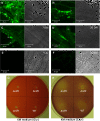Improvement of plant growth and seed yield in Jatropha curcas by a novel nitrogen-fixing root associated Enterobacter species
- PMID: 24083555
- PMCID: PMC3879406
- DOI: 10.1186/1754-6834-6-140
Improvement of plant growth and seed yield in Jatropha curcas by a novel nitrogen-fixing root associated Enterobacter species
Abstract
Background: Jatropha curcas L. is an oil seed producing non-leguminous tropical shrub that has good potential to be a fuel plant that can be cultivated on marginal land. Due to the low nutrient content of the targeted plantation area, the requirement for fertilizer is expected to be higher than other plants. This factor severely affects the commercial viability of J. curcas.
Results: We explored the feasibility to use endophytic nitrogen-fixing bacteria that are native to J. curcas to improve plant growth, biomass and seed productivity. We demonstrated that a novel N-fixing endophyte, Enterobacter sp. R4-368, was able to colonize in root and stem tissues and significantly promoted early plant growth and seed productivity of J. curcas in sterilized and non-sterilized soil. Inoculation of young seedling led to an approximately 57.2% increase in seedling vigour over a six week period. At 90 days after planting, inoculated plants showed an average increase of 25.3%, 77.7%, 27.5%, 45.8% in plant height, leaf number, chlorophyll content and stem volume, respectively. Notably, inoculation of the strain led to a 49.0% increase in the average seed number per plant and 20% increase in the average single seed weight when plants were maintained for 1.5 years in non-sterilized soil in pots in the open air. Enterobacter sp. R4-368 cells were able to colonize root tissues and moved systemically to stem tissues. However, no bacteria were found in leaves. Promotion of plant growth and leaf nitrogen content by the strain was partially lost in nifH, nifD, nifK knockout mutants, suggesting the presence of other growth promoting factors that are associated with this bacterium strain.
Conclusion: Our results showed that Enterobacter sp. R4-368 significantly promoted growth and seed yield of J. curcas. The application of the strains is likely to significantly improve the commercial viability of J. curcas due to the reduced fertilizer cost and improved oil yield.
Figures






References
-
- Barton PK, Atwater JW. Nitrous oxide emissions and the anthropogenic nitrogen in wastewater and solid waste. J Environ Eng. 2002;6:137–150. doi: 10.1061/(ASCE)0733-9372(2002)128:2(137). - DOI
-
- Crutzen PJ, Mosier AR, Smith KA, Winiwarter W. N2O release from agro-biofuel production negates global warming reduction by replacing fossil fuels. Atmos Chem Phys. 2008;6:389–395. doi: 10.5194/acp-8-389-2008. - DOI
LinkOut - more resources
Full Text Sources
Other Literature Sources

